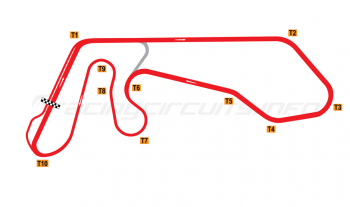Mine Circuit
Circuit Overview
Mine Circuit (みねサーキット) has enjoyed a long history under a variety of different names, hitting its heights in the early 1990s following a highly-publicised rebuilding in a bid to land a Formula One race. This included sponsorship of the Larrousse team under the Central Park banner.
While this was ultimately unsuccessful, the circuit nevertheless continued as a major venue for the domestic series, hosting Formula Nippon and Super GT until 2002, when its operating company went bust and was sold on to new owners.
It was sold again to Mazda in 2006 and has now closed to racing, though continues its life as one of the motor manufacturer's Japanese proving grounds.
Circuit History
The track, located near Mine City in Yamaguchi Prefecture, began as a much more humble facility. Opening at the end of 1972, the Atsu Circuit – as it was then known – was a mere 0.8 miles in length, with seven corners packed into its roughly triangular parcel of land. With the exception of the first spring race of the 1973 season, all races were run anti-clockwise.
The circuit proved a success and by 1976 it was extended to 1.8 miles and renamed the Nishi-Nihon Circuit (sometimes also referred to as Nishi-Nippon Circuit, both of which translate as West Japan Circuit). The course featured a lightly banked hairpin but retained much of the twisty infield. In this guise it carved out a useful niche in Japanese national racing, even hosting Formula Three and All-Japan Touring Car rounds.
By the 1990s, the ambitions were much higher and the course was expensively reconstructed, this time under the Central Park Mine Circuit name. A golf course and country club also formed part of the complex. In a bid to land a Grand Prix, the Central Park name adorned the Larrousse Formula One cars, although ultimately without any success. The track did however become home to all of the top championships in Japanese car racing, from Super GT and Formula Nippon to F3 and touring cars.
The layout, while featuring a long main straight, remained tight and twisty over its remainder. It also featured a low-grip surface which tended to make conditions treacherous in Japan's ever-possible wet weather. It quickly became known as a circuit that could throw up surprise results and favoured vehicles with good mechanical grip.
While the racing action may have been relatively healthy, the economics of the circuit were not and, by 2002, the operating company was declared bankrupt. Ownership transferred to a subsidiary of electric car company CQ Motors shortly afterwards and the circuit continued to operate. Then in January 2006, the owners of CQ Motors, Japanese toy manufacturers Takara, announced the closure of several unprofitable subsidiaries, the Mine Circuit included. New buyers were sought and in stepped Mazda, which quickly concluded a deal, effectively ending the track's racing history in February 2006.
Since then Mazda has used the circuit exclusively as a vehicle testing course and has added a large rollover test section, high speed straights for slalom performance testing, a European style mid-range handling road course and a high speed hill climb / low friction road for brake system assessment.
Jump onboard
Circuit info
Rate This Circuit
Votes: 4876
Get your race tickets!
Brought to you with: 
We've teamed up with Motorsports Tickets to bring you the best deals for Formula One, MotoGP, Le Mans and more.












